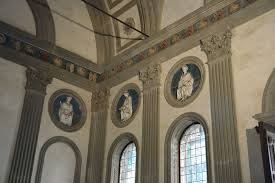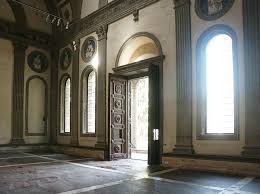Two similar chapels went up in Florence in the middle of the 15th century:
the Pazzi Chapel (1429 mentioned, built 1442-1461)

and the Chapel of the Cardinal of Portugal (1460-61.)
Both used the grey pietra serena stone against the white plaster to shape the space, both had barrel vaults with coffers, and both contain glazed terracotta decorations made by Luca Della Robbia.

Both were both set within major church complexes in Florence and they both had very wealthy
patrons to pay for the decoration, but these chapels had different functions and were set up for different reasons. The Pazzi Chapel was the chapter house of the Church of Santa Croce in Florence,
the place where the Franciscan monks of Santa Croce held their prayer meetings. Consequently, the space is a large rectangle, is domed, light-filled, and has built-in benches of pietra serena (grey stone) around nearly every wall.


It is a cool place to be in the hot Italian sun, and it has marvelous acoustics. (Try singing Dona Nobis Pacem with someone in harmony there and you will find the harmony hangs in the dome to beautiful effects.) The place was conceived and constructed with sound in mind since the monks would have
chanted their prayers often.
Andrea de' Pazzi paid for the construction of the chapter house and was allowed burial
rights behind it; we see no sign of his family tombs in the main building. The decoration of the interior of the chapel is decorously Christian . The four glazed terracotta sculptures by Della Robbia in the ceiling are of the FOUR EVANGELISTS: here from top left in clockwise motion: Luke with the ox, John with the eagle, Matthew with the angel, and Mark with his lion.
Below each Evangelist are two sculpted dolphins, the logo of the Pazzi Family designed by Donatello
(and also placed on the edge of their Palazzo on Via Proconsolo.)
The decoration on the side walls consists of roundels of the 12 apostles (after Judas left the company and was replaced).

Only the interior dome over the altar in a small square chapel off the center of the rectangle has a fresco painted on it that might be considered secular: it is a painting of the sky constellations, some signs of the zodiac.
The Pazzi family and the monks of Santa Croce could perform the religious services conducted in this ample space and still enjoy the geometric proportions of the architecture, the echoes of the dome in the terracotta roundels of the Evangelists, and the white apostles on the wall, also in roundels. The measure of their own spiritual lives was enhanced with these examples of piety before them as they met or chanted or prayed. The simple, clear, well-lit space
allowed for inner contemplation and peace.
The Chapel of the Cardinal of Portugal is much smaller, made in a square shape, and was never meant to have a public function. It was a private burial chapel for a cardinal from Portugal who died quite by accident in Florence on his way from Rome to Mantua. He was the grandson of the King of Portugal, his aunt was the Duchess of Burgundy; he was, in effect, both a Cardinal and a Prince. His relatives were all very rich. Money poured in to decorate the tomb of James of Lusitania because he died at age 26, a very handsome young person. Unusual death at an age considered too soon. But fortunate for him that he died in Florence, the center of great artists.


Two brothers, Antonio Rossellino and Bernardo Rossellino sculpted his tomb. They imagined him lying in state in a room where marble curtains are drawn back and angels and putti alight on the sarcophagus. Behind his marble body two angels fly in with a roundel sculpture of the Madonna and Child.
The whole wake to which the viewer is given privilege is brought to life with the angels and putti moving in a circle around the body.
The angel on the left brings a crown to symbolize his connection to the royal houses of Europe. The angel on the right originally had a palm frond, the symbol of martyrdom (though technically, he was not martyred.)

White marble carved in exquisite fashion, red porphyry marble (the most expensive color) for the back wall, egg-and-dart on the moulding of the angels' pilasters (egg-and-dart decoration is the symbol of eternal life), and frescoed angels in the spandrels of the arch who pull on the fictive curtains to open the scene for us! AND THAT's just ONE WALL!
The back wall has the altar and a painting by Antonio and Piero Pollaiuolo (1467-68) of three standing saints: Vincent, James (name saint), and Eustace.
Here, too, behind the panel fictive frescoed angels draw back fictive curtains to reveal the infinite landscape of the painting, which recedes to the Arno River Valley in the background of the saints.
The name saint points to himself and looks over at the bier with the reposing statue of
the Cardinal James. St. James holds a staff, wears sandals, and we see his hat, all of these symbols of
the pilgrimage to Santiago de Campostelo (St. James of Campostelo.) St. Vincent is in the painting
on the left (the painting is a copy, of course, in the chapel now; the original is in the Uffizi) because he was the patron saint of Lisbon and Portugal. St. Eustachio on the right is in the painting because
Cardinal James (Jacopo) was made the Cardinal of the church of St. Eustachio in Rome. (St. Eustachio, the church, is in the zone near the Pantheon and is famous for a deer with antlers on its facade, reminders of the miracle witnessed by St. Eustace of the crucified Christ between the antlers of a deer.)
Painting, frescoes, sculpted marble, porphyry marble - what other kinds of decoration could
be included? The tomb is on the right, the altar at the back. On the left of the chapel is an empty
bishop's chair, the CATHEDRA,

and painted behind the chair is the Annunciation by Alessio Baldovinetti. We are invited to the cardinal's wake, we are invited to participate in the mass, and we are invited to mourn his passing.
Baldovinetti paints the Annunciation as a sign
of new life, however. The Virgin here places her hand
over her newly pregnant belly as she raises her
other hand and lowers her eyes in a gesture of
REFLECTION. Portrait of Alessio Baldovinetti

There was only the ceiling and the floor to
complete this wonderfully lavish chapel to a
cardinal/prince (perhaps remembering John F.
Kennedy, Jr. and his young death may evoke
the kind of response the providers of this
chapel had in mind when they made sure the
best artists were employed.)
The floor is done in COSMATI work, a type of intricate mosaic pattern using precious stones,
including, in this case, and something hard to see in the photographs, lots of prophyry marble (the most expensive red kind.)
The pattern in the floor mirrors the arrangement in the ceiling where, when we look up, we find four CARDINAL VIRTUES: PRUDENCE, TEMPERANCE, FORTITUDE, and JUSTICE.
The codes we have come to expect in Italian Renaissance art are all here: the VIRTUES are WOMEN, they carry their attributes so they are recognizable, and they represent the special qualities that this Cardinal embodied; he had been imprisoned by his uncle in Portugal for a year and had survived and escaped; he had decided on a life in the church after that experience, so Prudence and Temperance and Fortitude were all virtues known to have helped him. Prudence has her snake and mirror for self-knowledge,
Temperance her pitcher and bowl for measured reason, as she measures imaginary liquid from one to the other,
Fortitude has a shield and mace.
And Justice was added by his relatives for the resolution of the civil war in Portugal which had led to his imprisonment in the first place.
Justice holds a sword and orb and this Justice has wings, as if Justice were an idea floating through
space. In fact, all of these VIRTUES have wings, unlike most of the VIRTUES on the BAPTISTERY in FLORENCE. In the center of the ceiling is the DOVE of the HOLY SPIRIT,
so these VIRTUES may be the SENECAN ones but they have a theological tinge because of the interior church setting. The human figures in the chapel, the saints, the virtues, the Madonna and angels all counter the material message of the wealth spent on the making of it. It is the spirit of the man that is celebrated here. The painted, sculpted, and glazed figures here all speak of a need to
substitute for what was ultimately lost and what even the artists would like to bring back.




































No comments:
Post a Comment